Bienvenidas y bienvenidos al Módulo 3, donde hablamos sobre el proceso de planificación y las diferentes herramientas del Programa que apoyan el desarrollo del Plan de Resiliencia Comunitaria (CRP, por sus siglas en inglés). Encontrarás información sobre las diferentes herramientas, y a través de los ejemplos, conocerás cómo la comunidad La Pesca utilizó el Marco de Planificación (el Marco) y las herramientas disponibles para llevar a cabo su proceso de planificación comunitaria y desarrolló su CRP.
Principalmente, hablaremos del Marco y los Logros del proceso de planificación, ya que este describe los pasos a seguir. También conocerá los Mapas de Activos de Capital Social, los Mapas Interactivos de Vulnerabilidad y Riesgos, el Portal Interactivo de Índices e Indicadores de Vulnerabilidad y Riesgo y el Manual de Intervención Comunitaria.
Al final de este módulo, tendrás un mejor entendimiento de las herramientas que tienes a tu disposición para investigar, analizar y desarrollar las estrategias necesarias para fortalecer la resiliencia de tu comunidad de manera participativa. Los Módulos 1 y 2 también te ayudarán en este proceso.
In the second unit, you will understand the importance of conducting a participatory community planning process to obtain a Resilience Plan relevant to the community.
What is a plan? We develop plans daily to establish the steps to follow to achieve visions and goals based on our needs. Some of these plans are small, personal and we don't put them on paper. Others are larger, and we need to gather the people who will be affected or involved. In this way, we can develop an actionable plan that considers all points of view. The same applies for the development of a community plan. The participation of residents and all stakeholders is needed to consider needs and possible resources available. In this way, the resulting Plan will represent the reality and needs of the community.
It is essential to develop just relationships where the community has the power to define its resilience needs, its vision of its future, and the resilience actions it desires to implement.
At the end of this unit, you will learn about the community participation model and its importance in achieving an effective planning process for CRP development. In addition, you will discover an example of a participatory approach using the Planning Framework and how to present the information in an accessible and fun way.
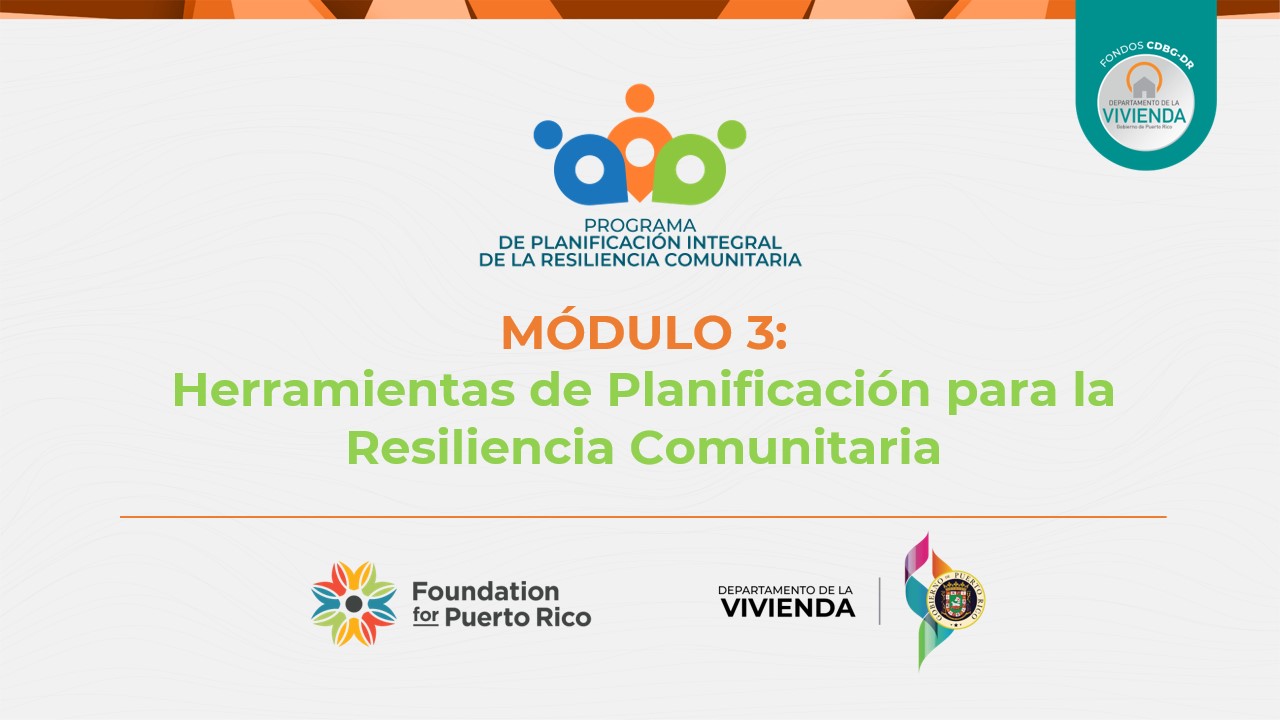
A continuación, compartimos un desglose de las herramientas que ofrece el Programa y algunos conceptos clave que escucharás al navegar las cuatro video-cápsulas sobre las Fases del proceso de planificación según el Marco.
Mapas Interactivos de Vulnerabilidad y Riesgo
Mapas Interactivos de Capital Social
Manual de Intervención Comunitaria y Recopilación de Datos
Portal Interactivo de Indicadores de Vulnerabilidad y Riesgo
Planificación
Marco de Planificación
Guía de Implementación del Marco y los Logros de Planificación
Plantilla CRP
Conceptos Importantes
In this section we share a summary of the tools offered by the WCRP Program and some of the key concepts you will encounter as you navigate through the four video capsules on the Phases of the planning process according to the Framework.
Interactive Vulnerability and Risk Maps
Interactive Social Capital Maps
Community Intervention and Data Compilation Manual
Interactive Vulnerability and Risks Portal
Planning
Planning Framework
Planning Framework and Milestone Implementation Guide
Community Resilience Plan (CRP) Template
Important Concepts:
En el Módulo 1 aprendimos lo que es un Plan de Resiliencia Comunitaria y cómo podría apoyar el proceso de recuperación luego de los huracanes Irma y María del año 2017. En el Módulo 2 aprendimos sobre métodos participativos para comunicar y organizarnos durante el proceso de planificación. Ahora, ¿cómo hacemos un Plan? ¿Cuáles son los pasos que debemos seguir?
Los siguientes cuatro videos explican brevemente de qué se trata cada una de las cuatro Fases de planificación del Programa, utilizando el Marco de Planificación y los Logros como referencia. Cada Fase sirve de guía sobre los pasos a seguir y acompaña el proceso de planificación.
En el Marco encontrarás información, detalles, métodos, teoría, ejercicios y herramientas prácticas. Aunque el documento del Marco puede ser un poco denso, los videos ayudarán a compartir la información de manera breve y accesible.
In Unit 1 we learned what a Community Resilience Plan is and how it could support the recovery process after Hurricanes Irma and Maria in 2017. In Unit 2 we learned about participatory methods to communicate and organize ourselves during the planning process. At this point we will focus on; how do we develop a plan? and what are the steps we need to follow?
The following four videos briefly explain the four Phases of WCRP Planning Program, using the Planning Framework and Milestones as a reference.
Each Phase serves as a step-by-step guide and supports the planning process. In the Framework you will find information, details, methods, theory, exercises, and practical tools. Although the Framework can be a dense document, the videos will help to facilitate the discussion of the information in a brief and accessible way.




Las fichas presentan un resumen de cada una de las Fases de una manera sencilla y accesible, utilizando el ejemplo de la comunidad La Pesca. Encontrarás qué esperar de cada Fase, sus Logros y algunos recursos.
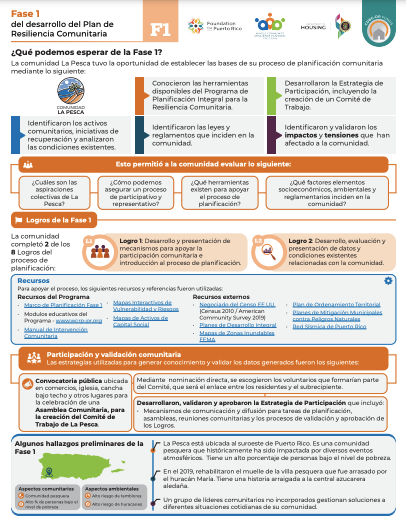
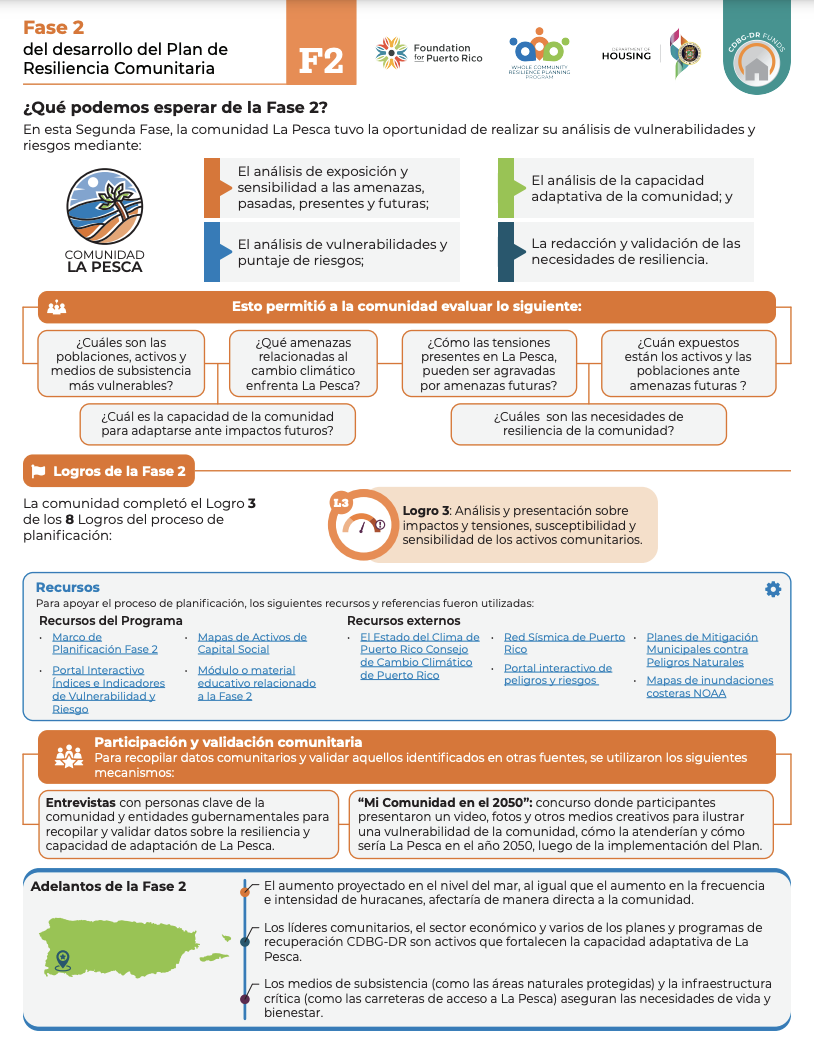
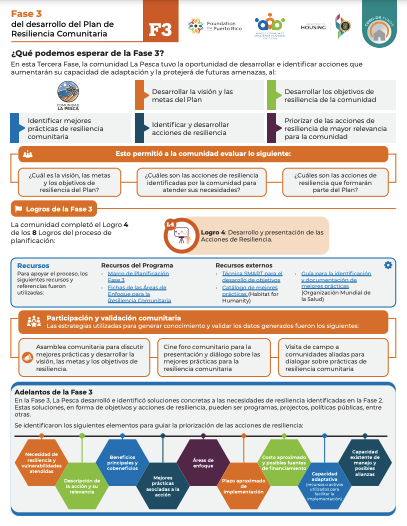

The Planning Framework Snapshots show a summary of each of its four (4) Phases in a simple and accessible way, using the example of La Pesca community. The Snapshots includes what to expect from the Phases, the Milestones, and some resources. In addition, you will find an example of some of the outcomes of La Pesca for each of the Phases.




A continuación, el Resumen Ejecutivo de La Pesca presenta un ejemplo de lo que sería su Plan de Resiliencia Comunitaria. Un Resumen Ejecutivo es un resumen que se incluye al principio del CRP para desglosar, de manera rápida, los hallazgos y acciones identificadas. Este resumen brinda una idea sencilla sobre qué esperar de esta sección en el CRP final.
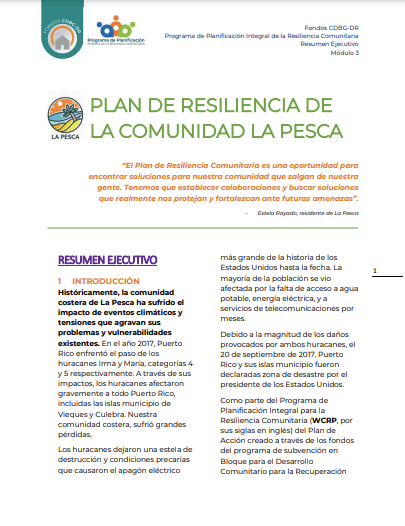
La Pesca's Executive Summary outlines an example of what a Community Resilience Plan would look like. An Executive Summary is a synopsis that is included at the beginning of the CRP to summarize the findings and actions identified. This summary provides a simple idea of what to expect from this section in the final CRP.
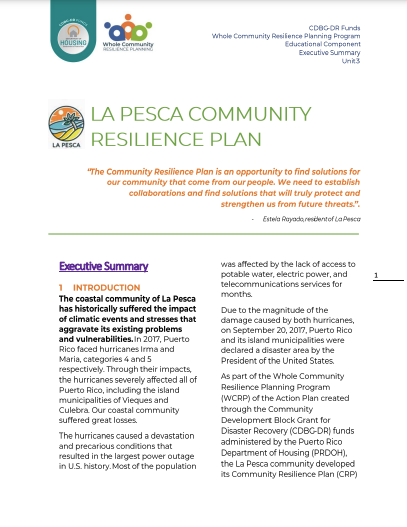
Mientras exploras las herramientas disponibles para el proceso de planificación, puedes contemplar las siguientes preguntas:
- ¿Conocías los conceptos de amenaza, tensión, riesgo o vulnerabilidad?
- ¿Qué herramientas te parece que son las más útiles para tu comunidad? ¿Porqué?
- ¿El proceso de planificación te parece accesible? ¿Qué información adicional hace falta para tener un mejor entendimiento de las tareas que se van a realizar?
- ¿Crees que cada fase tiene suficientes oportunidades u opciones para insumo comunitario representativo?
- ¿Qué retos podría enfrentar tu comunidad durante el proceso de planificación? ¿Existen maneras de atenderlos o minimizarlos?
- ¿Las condiciones existentes de la comunidad La Pesca, son similares a las de tu comunidad? ¿En qué se parecen o se diferencian?
- ¿Crees que las acciones de resiliencia identificadas por la comunidad La Pesca son las más adecuadas para enfrentar sus vulnerabilidades? ¿Por qué?
- ¿Cuáles serían los principales retos a los que se enfrentaría tu comunidad y su Comité de Implementación y Monitoreo para alcanzar sus metas?
As you explore the tools available to assist the planning process, you may want to consider the following questions:
- Were you familiar with the concepts of threat, stress, risk, or vulnerability?
- Which tools do you think are most useful for your community? Why?
- Do you find the planning process accessible, and what additional information is needed to better understand the tasks to be performed?
- Do you think each phase has sufficient opportunities or options for representative community input?
- What challenges might your community face during the planning process and are there ways to address or minimize them?
- Are the existing conditions in the La Pesca community similar to those in your community, and how are they similar or different?
- Do you think that the resilience actions identified by the La Pesca community are the most appropriate to address their vulnerabilities? Why?
- What would be the main challenges your community and its Implementation and Monitoring Committee would face to achieve its goals?
